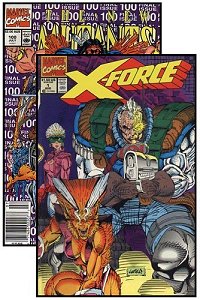Chapter 4: early to mid 1990s – the franchise explosion
By the time January 1991 rolled around, Marvel was publishing several X titles: Uncanny X-Men (1st series), New Mutants (1st series), X-Factor (1st series), Excalibur (1st series), Wolverine (2nd series) & Alpha Flight (1st series). Not only this, but Wolverine was appearing regularly in Marvel Comics Presents, making it a de facto X-title. However, change was in the air. Over the next several years the number of X-titles would balloon and keeping track of it would become much more difficult.
In April 1991, the first New Mutants series came to an end with #100. After almost eight years, the original premise of the series had changed and the former “new” mutants had grown up and were coming into their own as heroes. To reflect this change, as well as the new, militaristic direction taken by the team’s new leader, Cable, the team became X-Force, which began in August 1991.
For the first 70 issues, the team were instructed by or worked with their founder, Cable. In time, however, the team rejected their former mentor, choosing instead to operate on their own. Ostensibly still the same team originally founded as New Mutants so long ago, the members of X-Force by now had matured to adulthood and wished to stand on their own. For the next 46 issues they did just this, until #116 in 2001 when the title was retooled, becoming another X-Force in name only. However, until that time, the team’s roster would include founder members Cable, Cannonball, Domino, Boomer (later Meltdown), Feral, Shatterstar & Warpath. Later members would include Siryn, Sunspot, Rictor, Caliban, Moonstar (formerly Mirage), Jesse Aaronson & Pete Wisdom.
Years after the title’s ultimate cancelation with #129, the characters of the original series returned in 2004 in a six-issue mini-series named X-Force. Marking Rob Liefeld’s return to the concept of his creation, Cable gathered most of his earlier X-Force recruits for a mission against a threat from his time. All in all, the series was not terribly well received, as fans noted that much of the art was obviously drawn from a decade earlier and that most characters acted in ways that they had not in years. This in turn caused much confusion for readers and evident frustration from writers in whose books the characters were currently appearing. Still, the sales were enough to justify a prequel, X-Force: Shatterstar, which ran for four issues, beginning in April 2005. A third series, this one an ongoing, would follow 2008.
Between July and September of 1991, the Uncanny X-Men and X-Factor titles were involved in a storyline called “The Muir Island Saga.” In this crossover, Xavier’s oldest foe, the Shadow King, returned and wrought havoc on Moira MacTaggert’s island research station. Only through the combined forces of both teams was he defeated. However, instead of going their separate ways, the original and current X-Men decided to reunite as one team.
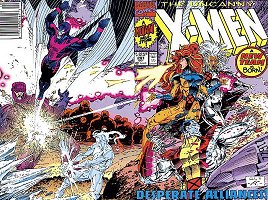 For the X-Men, now totaling 14, they were split into two groups: a “Blue” team and a “Gold” team. The Gold team, consisting of Jean Grey, Iceman, Archangel, Storm & Colossus, was featured in Uncanny X-Men, starting with #281. The next issue the time-traveling character of Bishop was introduced, and he would become an X-Man in #287. This roster would continue for several years, before writers began to blur the lines between the two teams, using the characters interchangeably and, on occasion, with the storyline weaving between the Uncanny X-Men...
For the X-Men, now totaling 14, they were split into two groups: a “Blue” team and a “Gold” team. The Gold team, consisting of Jean Grey, Iceman, Archangel, Storm & Colossus, was featured in Uncanny X-Men, starting with #281. The next issue the time-traveling character of Bishop was introduced, and he would become an X-Man in #287. This roster would continue for several years, before writers began to blur the lines between the two teams, using the characters interchangeably and, on occasion, with the storyline weaving between the Uncanny X-Men...

...and the other title which began in 1991. In October of that year, two weeks after Uncanny X-Men (1st series) #281, a new X-Men #1 graced the comic stands, the first since 1963. As the series of Uncanny X-Men had once been called the same title, this new series is referred to as X-Men (2nd series). Briefly between #114 & #156, the title was renamed New X-Men (referred to hereon as New X-Men (1st series), as another title took the name after it was renamed to the adjectiveless “X-Men” with #157).
This second X-Men title starred the group's “Blue” team, which consisted of Cyclops, Psylocke, Wolverine, Jubilee, Beast, Gambit & Rogue. Like the Uncanny title, this roster would continue for several years, until the editorial styles caused the two titles to end the concept of separate squads.
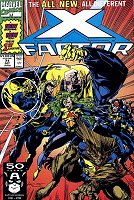 With the original X-Men leaving X-Factor to become X-Men once again, this left a title without a cast. However, out of the Muir Island Saga, several of the isle’s inhabitants were recruited by Val Cooper of the Commission on Superhuman Activities to form a government-sponsored team, to replace the recently defunct Freedom Force. As of #71 of X-Factor (1st series), the new X-Factor was born, consisting of Havok, Polaris, Quicksilver, Strong Guy, Multiple Man and Wolfsbane. Later members would include Forge, Mystique, Wildchild, Sabretooth, Shard, Archer, Fixx & Greystone.
With the original X-Men leaving X-Factor to become X-Men once again, this left a title without a cast. However, out of the Muir Island Saga, several of the isle’s inhabitants were recruited by Val Cooper of the Commission on Superhuman Activities to form a government-sponsored team, to replace the recently defunct Freedom Force. As of #71 of X-Factor (1st series), the new X-Factor was born, consisting of Havok, Polaris, Quicksilver, Strong Guy, Multiple Man and Wolfsbane. Later members would include Forge, Mystique, Wildchild, Sabretooth, Shard, Archer, Fixx & Greystone.
This new X-Factor would go through tumultuous times, rebelling against their government handlers and going rogue. After 12 years of publication, the series ended in September 1998 with #149. The series was cancelled to make room for Mutant X, which debuted the next month to chronicle the adventures of one of X-Factor’s members, who found himself transported to an alternate reality whereas the rest of the world believed him dead. The series was slated to resume, after the first 12-issue arc of Mutant X finished, however the new series became popular enough to continue on its own. This left X-Factor in permanent hiatus and plot lines hinted to be concluded in the never-published #150 and afterward (such as the assassin of Graydon Creed) lingering danglers.
Two years after the X-Force series began, the character who had been the driving force behind the change, the enigmatic Cable, received his own series. In 1992, Cable had been given a 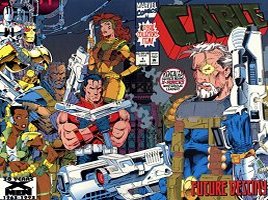 two-issue miniseries sub-titled “Blood & Metal,” which explored some aspects of his past. In May 1993, he received an ongoing series, hereon called Cable (1st series), as many years later it would be followed by another of the same name. Lasting 107 issues before being cancelled in September 2002, the Cable series would have more changes in tone and direction than any other X-title. Originally conceived as a “soldier’s soldier,” his weapon of choice being obscenely large firearms, the character evolved into one with a more cerebral methodology, even foregoing actual guns for his “Psimitar,” through which he would channel his mental abilities. Later in the series' run, Cable went down the path of global freedom fighter, even dancing on the edge of being a messiah figure. The series’ ultimate cancellation was more of another X-“retooling,” as it was replaced with another title with the same creative team and direction, becoming “Soldier X.”
two-issue miniseries sub-titled “Blood & Metal,” which explored some aspects of his past. In May 1993, he received an ongoing series, hereon called Cable (1st series), as many years later it would be followed by another of the same name. Lasting 107 issues before being cancelled in September 2002, the Cable series would have more changes in tone and direction than any other X-title. Originally conceived as a “soldier’s soldier,” his weapon of choice being obscenely large firearms, the character evolved into one with a more cerebral methodology, even foregoing actual guns for his “Psimitar,” through which he would channel his mental abilities. Later in the series' run, Cable went down the path of global freedom fighter, even dancing on the edge of being a messiah figure. The series’ ultimate cancellation was more of another X-“retooling,” as it was replaced with another title with the same creative team and direction, becoming “Soldier X.”
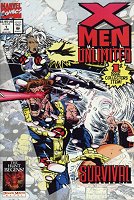 In 1993, Marvel Comics introduced a new line of quarterly comics called Unlimiteds. The concept behind these titles was to tell stand-alone stories that would not fit in the regular ebb and flow of monthly storytelling. As a result, the quarterly 48–page comic could contain two 22-page stories or one lasting a double-sized 48-pages. Along with the Fantastic Four, Spider-Man and Midnight Sons, X-Men Unlimited was launched in June, 1993. With #34 in March 2002, the title went from quarterly to monthly and the page count was reduced to 22 pages. The title lasted a total of 50 issues, cancelled in September 2003. This series was replaced with a second series in 2004, which lasted just 14 issues, canceled in 2006.
In 1993, Marvel Comics introduced a new line of quarterly comics called Unlimiteds. The concept behind these titles was to tell stand-alone stories that would not fit in the regular ebb and flow of monthly storytelling. As a result, the quarterly 48–page comic could contain two 22-page stories or one lasting a double-sized 48-pages. Along with the Fantastic Four, Spider-Man and Midnight Sons, X-Men Unlimited was launched in June, 1993. With #34 in March 2002, the title went from quarterly to monthly and the page count was reduced to 22 pages. The title lasted a total of 50 issues, cancelled in September 2003. This series was replaced with a second series in 2004, which lasted just 14 issues, canceled in 2006.
Ever since the New Mutants series became X-Force in 1991, there was a distinctive lack of the “school for mutants” theme in the X-universe. That changed in November 1994, with the launch of “Generation X.” The series was an offshoot of a 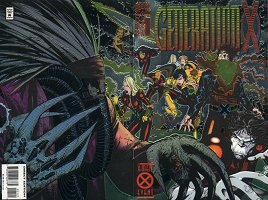 crossover of the X-titles called the “Phalanx Covenant.” Young mutants had been gathered by a technological alien race that wished to acquire them for transformation into their kind. After they were stopped, Xavier and Emma Frost decided to open a new school, this time in the Massachusetts’ Academy in Boston.
crossover of the X-titles called the “Phalanx Covenant.” Young mutants had been gathered by a technological alien race that wished to acquire them for transformation into their kind. After they were stopped, Xavier and Emma Frost decided to open a new school, this time in the Massachusetts’ Academy in Boston.
This initial class of Jubilee, Synch, M (later Penance II), Husk, Skin, Chamber & Penance (later M II) became Generation X. Their ranks were later joined by Artie Maddicks, Leech, Gaia & Penance III. Very much like their earlier incarnation, the New Mutants, the students of Generation X were not meant to be heroes… although they always seemed to find their share of adventure and trouble. The series lasted for 75 issues, cancelled in May 2001 during another restructuring period of Marvel’s X-titles.
Chapter 5: mid 1990s to 2001 – a runaway franchise
The mid 1990s were a tumultuous time for Marvel and comics in general. A culture of speculation buying had taken over readers and the larger publishers were selling more and more titles in order to gain market share. The fact that #1s of new series kept selling record copies (record for modern times) only helped fuel the fire. 1991’s X-Force #1 record sales, for instance, were surpassed only a few months later by 1991’s X-Men #1.
 By February 1995, the main X-titles being published were at this point: X-Factor (1st series) #110, Uncanny X-Men (1st series) #321, X-Men (2nd series) #41, Wolverine (2nd series) #90, Cable (2nd series) #20, Generation X #4, X-Force (1st series) #43, X-Men Unlimited (1st series) #7. In March of 1995, Marvel had an event which was unlike any other in the past, leading to the cancellation of all the X-titles. For awhile, that is.
By February 1995, the main X-titles being published were at this point: X-Factor (1st series) #110, Uncanny X-Men (1st series) #321, X-Men (2nd series) #41, Wolverine (2nd series) #90, Cable (2nd series) #20, Generation X #4, X-Force (1st series) #43, X-Men Unlimited (1st series) #7. In March of 1995, Marvel had an event which was unlike any other in the past, leading to the cancellation of all the X-titles. For awhile, that is.
From March to June 1995, all of the X-titles were cancelled and replaced with another title, which was published for 4 issues. This was the result of a storyline called Legion Quest, which caused the timeline for the entire Marvel Universe to be altered to one where the X-villain Apocalypse had ruled America for over a decade. This new world, as well as this most monstrous X-crossover yet, was called the Age of the Apocalypse.
 While the Age of the Apocalypse was brought to an end and “normality” was restored, there were a few things that remained. During the event, the title of Cable had been replaced with another called X-Man, which starred a character who was the genetic progeny of Scott Summers and Jean Grey (much like Cable’s parents of Scott Summers and Madelyne Pryor, a clone of Jean Grey). While not a direct correlation, the similarities were enough to make them effectively siblings. More importantly, the character was considered interesting enough to keep around. After the Age of Apocalypse was over, this one of the “transformed” titles was kept. X-Man would run for #75 issues, eventually cancelled in May 2001.
While the Age of the Apocalypse was brought to an end and “normality” was restored, there were a few things that remained. During the event, the title of Cable had been replaced with another called X-Man, which starred a character who was the genetic progeny of Scott Summers and Jean Grey (much like Cable’s parents of Scott Summers and Madelyne Pryor, a clone of Jean Grey). While not a direct correlation, the similarities were enough to make them effectively siblings. More importantly, the character was considered interesting enough to keep around. After the Age of Apocalypse was over, this one of the “transformed” titles was kept. X-Man would run for #75 issues, eventually cancelled in May 2001.
As large as the Age of Apocalypse was, Marvel decided for another mega-crossover a year later. This would be known as the Onslaught crossover, which became a crossroads for many stories. First, it was the culmination of the “X-traitor” mystery, which had been around since Bishop’s arrival in the 20th century. Also, it tied together the Fatal Attractions crossover of 1993, bringing to light the ramifications of Xavier “mind-wiping” Magneto. Lastly, it tied into continuity a reason for the upcoming event where Marvel was canceling Fantastic Four, the Avengers, Captain America and Iron Man, replacing them for 12 months with a rebooted version called Heroes Reborn. Since these non-mutant heroes (who were popular with the people, unlike the X-teams) were seemingly killed (in actuality being placed into a “pocket dimension” by Franklin Richards) the public had an even greater reason to distrust and hate mutants. Of course, the FF & Avengers eventually returned in the miniseries unimaginatively named “Heroes Reborn: The Return” in 1997.
Also coming in 1997 was yet another title - Deadpool. Not quite a mutant, the character was still inexorably intertwined with the X-titles, having first appeared in New Mutants (1st series), been a consistent pain in the side of X-Force and later revealed to have involved with the Weapon X program in the past. By the time his ongoing series started, Deadpool had already enjoyed two four-issues miniseries. The first in 1993 was actually named Deadpool: the Circle Chase, while the second in 1994 was simply “Deadpool.” As a result, this new title is referred to as Deadpool (2nd series).
During its run, Deadpool would mix action with black humor and be one of the rare comic that routinely broke the “Fourth Wall,” its characters speaking directly to the readers. The series eventually ended with #69 in September 2002 with the apparent death of the “merc with a mouth.” Later that same month, the title of Agent X began, which featured an amnesiac character who might possibly have been a reincarnated Deadpool. Later, it was determined that this was not the case, as demonstrated when Agent X clashed with the very much still living Deadpool. Although a critical success, low sales caused the series to end with #15 in December 2003. A few months later it was to be replaced with the combo title of Cable/Deadpool.
 Another X-character was soon to get his own ongoing series – Gambit. Like Deadpool, Gambit had already enjoyed two four-issue miniseries, the first in 1993 and the second in 1994. Because of this, his first ongoing series is referred to as Gambit (3rd series). This title lasted only 25 issues, being cancelled in February 2001. A fourth Gambit series, lasting only 12 issues, would begin in 2004, and a fifth one in 2012.
Another X-character was soon to get his own ongoing series – Gambit. Like Deadpool, Gambit had already enjoyed two four-issue miniseries, the first in 1993 and the second in 1994. Because of this, his first ongoing series is referred to as Gambit (3rd series). This title lasted only 25 issues, being cancelled in February 2001. A fourth Gambit series, lasting only 12 issues, would begin in 2004, and a fifth one in 2012.
Of the Uncanny X-Men offshoot titles of the 1980s, only two remained: X-Factor & Wolverine. As of 1998, there would be only one. As stated earlier, in October 1998, X-Factor was placed on hiatus (later effectively canceled) and replaced with Mutant X. In this title, Havok found himself very much alive in an alternate dimension, whose history had turned out quite different. Replacing the Havok of this timeline, Havok made this new world his home, until he could find his way back. Many considered the Mutant X series very imaginative, especially in the early issues. However, the series was cancelled after 32 issues, in June 2001.
 Another new solo series was launched in 1999, this one for the character of Bishop. Actually, Bishop had already had several miniseries before, the eponymously titled “Bishop” miniseries in 1994, another called X.S.E. in 1996 and Bishop: XSE in 1998. However this new series was named slightly different: Bishop: The Last X-Man. Like the Mutant X series, in this title the titular character found himself in another timeline. Bishop would have several extra-dimensional adventures before returning to the X-Men’s time period during the 2000 crossover, Maximum Security. Bishop’s series was cancelled shortly thereafter in January 2001 with #16. It should be noted that the “the Last X-Man” was dropped for #15 & 16, as Bishop had returned to the main Marvel Universe and was no longer the “last X-Man.”
Another new solo series was launched in 1999, this one for the character of Bishop. Actually, Bishop had already had several miniseries before, the eponymously titled “Bishop” miniseries in 1994, another called X.S.E. in 1996 and Bishop: XSE in 1998. However this new series was named slightly different: Bishop: The Last X-Man. Like the Mutant X series, in this title the titular character found himself in another timeline. Bishop would have several extra-dimensional adventures before returning to the X-Men’s time period during the 2000 crossover, Maximum Security. Bishop’s series was cancelled shortly thereafter in January 2001 with #16. It should be noted that the “the Last X-Man” was dropped for #15 & 16, as Bishop had returned to the main Marvel Universe and was no longer the “last X-Man.”
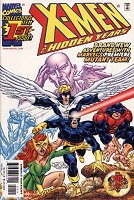 Before the end of 1999, in December, Marvel tried something new. When the first X-Men series was cancelled in 1970 with X-Men #66, the Marvel Universe continued on without the adventures of the team of young mutants. No longer in their own title, the teens made a few appearances in other titles but were otherwise inactive. In December 1999, John Byrne attempted to bridge the gap between X-Men (1st series) #66 and the first new adventures in Giant-Sized X-Men #1 & X-Men (1st series) #94 with a title called X-Men: The Hidden Years. The idea was to show what the team was up to between those years and incorporate what had been depicted in their other series. Unfortunately, while the series was well received and sales were reportedly decent, it was cancelled after only 22 issues in September 2001 during a line-wide restructuring.
Before the end of 1999, in December, Marvel tried something new. When the first X-Men series was cancelled in 1970 with X-Men #66, the Marvel Universe continued on without the adventures of the team of young mutants. No longer in their own title, the teens made a few appearances in other titles but were otherwise inactive. In December 1999, John Byrne attempted to bridge the gap between X-Men (1st series) #66 and the first new adventures in Giant-Sized X-Men #1 & X-Men (1st series) #94 with a title called X-Men: The Hidden Years. The idea was to show what the team was up to between those years and incorporate what had been depicted in their other series. Unfortunately, while the series was well received and sales were reportedly decent, it was cancelled after only 22 issues in September 2001 during a line-wide restructuring.
May of 2000 was a time of change for the X-titles. The editorial powers-that-be decided to shake up the X-books with new directions for them all – which resulted in the event known as the Six-Month Gap. Sporting a “Revolution” logo to mark the occasion, every X-title had a six-month period of time pass between issues. For instance, six months time passed between Uncanny X-Men #380 & 381. For X-Men (2nd series), it was between #99 & 100.
The idea was to have a sudden shakeup of all the teams and titles, with new costumes, rosters and even powers. Because this was sudden and unexplained, the writers would have potential for months and years of storylines, explaining what had happened during the missing six months. To make this event even more special, Chris Claremont returned as writer of Uncanny X-Men, as of #381. His return in June 2000 was the first time he had written X-Men since December 1991.
Despite its build-up and the editorial energy behind it, the questions behind much of the Six-Month Gap period would go unanswered. A little over a year after Revolution, new editorial decisions caused yet another revamp to the X-titles, causing almost all of the mysteries to be forgotten.
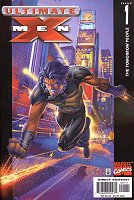 Marvel had tried several times since the mid-1980s to create a line of titles outside of the normal “616” Marvel Universe. Previous attempts include the the New Universe, the 2099 line and Marvel Next. However, arguably the most popular and well received was the Ultimate Marvel line, which began with Ultimate Spider-Man in 2000.
Marvel had tried several times since the mid-1980s to create a line of titles outside of the normal “616” Marvel Universe. Previous attempts include the the New Universe, the 2099 line and Marvel Next. However, arguably the most popular and well received was the Ultimate Marvel line, which began with Ultimate Spider-Man in 2000.
The idea was to create a new universe, with existing characters, but update them in a more modern theme. A side-effect would be that new readers would not have to know decades of history and continuity, so it would be perfect for a new generation of comic fans. At the same time, it would appeal to older readers, as it depicted the same characters they loved, but altered in subtle and interesting ways. With strong initial sales for Ultimate Spider-Man, which continued as the title progressed, Marvel felt confident enough to create other ultimate titles, among them Ultimate X-Men, which began in February 2001. For the first several years, the title’s sales rivaled that of the mainstream X-Men. However, in time, reader and editorial interest had declined in the Ultimate line of titles, leading to the cancelation of most of the line in early 2009. Ultimate X-Men ended with #100 and the entire Ultimate franchise came to a conclusion with the Secret Wars event in 2015.

